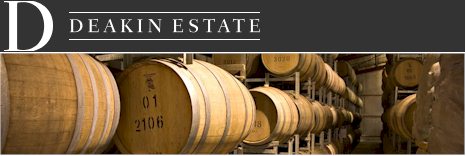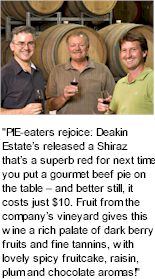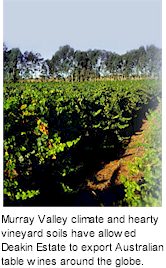


Deakin Estate vineyard and winery complex is at Red Cliffs, near Mildura in the Murray Valley of North West Victoria. Alfred Deakin, a former Prime Minister of Australia, encouraged California's Chaffey Brothers to bring their irrigation expertise to the vast inland valley of the Murray River in North West Victoria. Since then the region has become one of Australia's most productive and prosperous sources of high quality produce including citrus, olives, almonds and grapes.

Purchased in 1967, Deakin Estate was planted to premium wine grapes which were sold as fruit until 1980 when a winery facility was built. By the time the Deakin Estate range was launched in 1994 some vines had achieved considerable age, whilst newer vines were being planted. An ongoing regime of viticultural innovation accelerated, ensuring the high quality, varietally specific fruit that has underpinned the success of the brand.
Deakin Estate now has 350 hectares under vine. It is warm and sunny where the great Murray River brings life to the region. Deakin Estate's efforts are focussed on producing fruit of the highest quality and expressive wines brimming with flavour and varietal character.
Since then the investment in extensive vineyard plantings has allowed Australia to share Australian wines with customers around the world. Deakin Estate wines can now be found in 28 countries outside Australia. The devotion of the winemakers and grapegrowers deliver the high quality wines that have made Deakin Estate so popular. After crafting and bottling, the Estate takes great measures to oversee the wines on their journey from the winery to warehouses and shipping ports around the world.

Behind the scenes at Deakin Estate is an experienced and enthusiastic team. From the vineyard to the winery and inside to the operations department, a culture of commitment and innovation drives Deakin Estate. The Australian spirit of openness, good humour and integrity unites the winery's team and contributes, along with their other attributes, to the ultimate success of Deakin Estate wines.
Stretching over 350 hectares (865 acres) near the Murray River at Red Cliffs, the Deakin Estate vineyard is a model of successful contemporary viticultural management. The Australian spirit of openness, good humour and integrity unites the winemaking team and contributes, along with their other attributes, to the ultimate success of Deakin Estate wines.
The major varieties grown are Chardonnay, Sauvignon Blanc, Colombard, Semillon, Cabernet Sauvignon, Shiraz and Merlot. Deakin Estate are leaders in innovative vineyard techniques such as partial root zone drying, canopy management and yield monitoring. Agricultural research bodies and industry groups access the Deakin Estate vineyard for study purposes. In 2002 Deakin Estate received a Save Water Award for water conservation practices aimed at protecting the environment and future productivity of the region. Behind the scenes at Deakin Estate is an experienced and enthusiastic team. From the vineyard to the winery, throughout the entire operation, a culture of commitment and innovation drives the people of DEakin Estate, a quality ultimately reflected in the wines.
